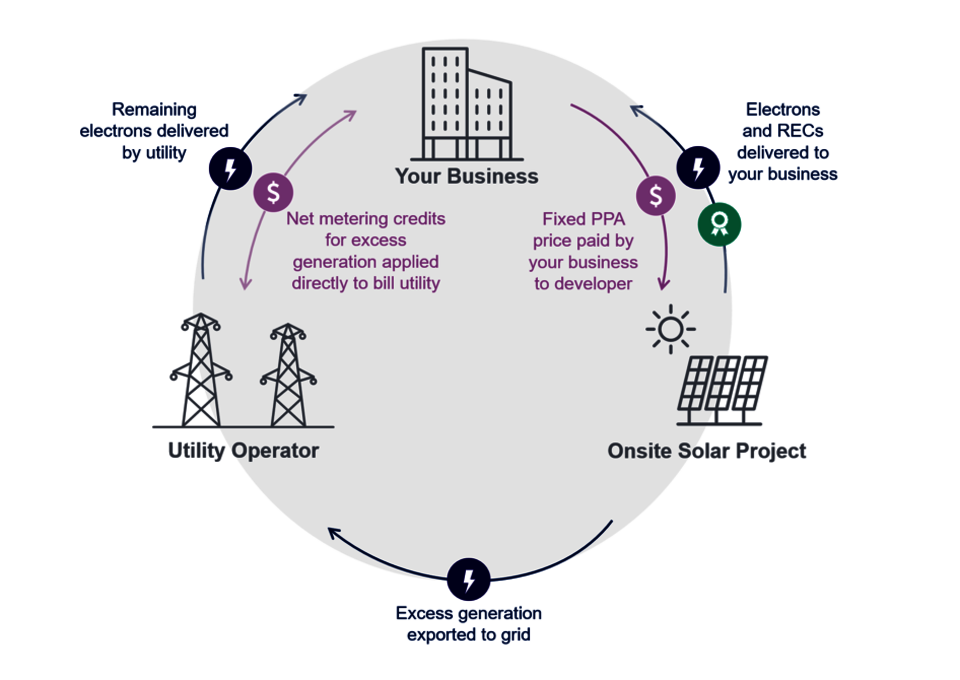Onsite Solar 101

By Kristen Pollock, Sr. Analyst, Distributed Clean Energy Advisory
What is onsite solar?
Onsite solar is an asset installed in the same location where the energy generated will be consumed. For each kilowatt-hour (kWh) the onsite solar asset produces, a kWh of consumption will be offset for a buyer of renewable energy, or offtaker. These systems are often described as “behind the meter” (BTM) because the facility can use the energy generated without it passing through a meter. With any renewable resource, for every Megawatt-hour (MWh) of electricity generated, an associated environmental attribute, known as a Renewable Energy Credit (REC), is also produced. A REC tracks progress toward each state’s Renewable Portfolio Standards (RPS), and it represents the energy produced from renewable energy sources.
Types of onsite solar
The most common types of onsite solar assets are ground-mounted, rooftop, and carport. When choosing which option is best, it’s important to consider the attributes and their feasibility before deploying them at a site. For instance, carports can provide the added benefit of shaded parking for a facility’s employees or customers. Still, they are typically more expensive to install and may be a cost-prohibitive option. Trio assists clients through an in-depth desktop review to help determine the optimal asset type(s) on a site-by-site basis.

Why onsite solar?
One of the benefits of pursuing onsite solar is making progress towards achieving renewable energy goals. This happens through the RECs generated by a solar asset, which can be retired to reduce a company’s Scope 2 emissions. Onsite solar projects provide RECs at a predetermined price and term length, which prevents uncertainty of cost and supply when otherwise procuring them from the voluntary market.
Onsite solar is often valuable for an organization’s renewables goals. Beyond its value as a stable source of RECs, onsite solar can be highly visible, making it a compelling way for companies to demonstrate a strong commitment to sustainability.
Onsite solar can provide operational savings and budget certainty. The most evident way is through the direct offset of energy consumption from the grid, resulting in electricity bill savings. Since the offtaker obtains the electricity generated from the system at a predetermined cost, there is a protective hedge against future increases in electricity costs for the project term.
A mechanism called net metering can provide additional savings. When the energy generated by a system is not consumed, net metering allows for the export of the excess generation to the grid. The offtaker can then be credited for each exported kWh, amounting to more savings on their electricity bill.
Onsite solar considerations
While the benefits of onsite solar are significant, many factors must be considered when choosing where, how, or whether to pursue it at your facilities.
- Available space: Unsurprisingly, space can be the most limiting factor for onsite solar. Adequate rooftop or land area is needed to achieve economies of scale and make onsite solar an economical option.
- Site conditions: Even with adequate space, site conditions can impede onsite solar. The structural integrity of roofing, the state of the existing electrical infrastructure, and environmental conditions can introduce limitations or additional development costs.
- Electricity rate: The savings generated by a system are directly related to the energy and demand rates applied to the facility. In regions where energy supply is very cheap, the cost of onsite solar will likely outpace the savings generated by it.
- Location: Solar policy and incentives vary across states and utilities and should be considered during site selection.
These constraints limit onsite solar, so subscribing to a community solar project can be a great alternative. In states with active community solar programs, subscribers can obtain savings on their utility bills and RECs. Stay tuned for a closer look at this in Trio’s upcoming Community Solar 101 blog post.
How to participate
Once an organization has decided to pursue onsite solar, the question that is top of mind is how to pay for it. There are generally three contract structures available to buyers:
Power Purchase Agreement
Under a Power Purchase Agreement (PPA), a developer will install, own, and operate the system and sell the generated energy to the buyer at a predetermined price ($/kWh). A PPA requires no upfront investment, making it an attractive option where capital may be limited. PPA rates also generally include system maintenance to ensure equipment issues are detected and addressed to achieve the expected generation.

Lease
In many states, policy does not allow for PPAs, so leases are available as a third-party ownership alternative. A solar lease operates like a PPA, where the main difference is that the buyer pays the developer a fixed monthly charge rather than a fixed fee ($/kWh) based on generation.
Direct Purchase
When a buyer is interested in owning the solar asset, they can choose to pay for the system with an upfront investment. This option can be attractive if the buyer has capital available to deploy and the appetite to take advantage of potential tax benefits. However, owning a system also introduces additional complexity. To do so often requires an experienced buyer who is prepared to manage the long-term operations and maintenance of the system either directly or through subcontracting, which a developer would otherwise handle under a PPA or lease agreement.
Trio assists clients in every step of the onsite solar evaluation process, from site selection to procurement to contract negotiations. With so many aspects to navigate through this process, our team empowers clients with the knowledge to take advantage of all the benefits onsite solar can offer, whether for a single location or a portfolio. If your company is interested in exploring how onsite solar can fit into its strategy or discussing other renewable procurement options, please get in touch with our team of experts here.
Summing it up
- Onsite solar is an asset located where the renewable energy generated will also be consumed.
- There are three main types of onsite solar: rooftop, ground-mount, and carport.
- Onsite solar can benefit the offtaker in many ways, including progress towards renewable energy goals, visible commitment to sustainability, and electricity bill savings.
- Several factors should be considered when deploying onsite solar, including space, site conditions, electricity rate, and state and utility policies and incentives.
- The three primary structures for financing a project are PPA, lease, and direct purchase.
